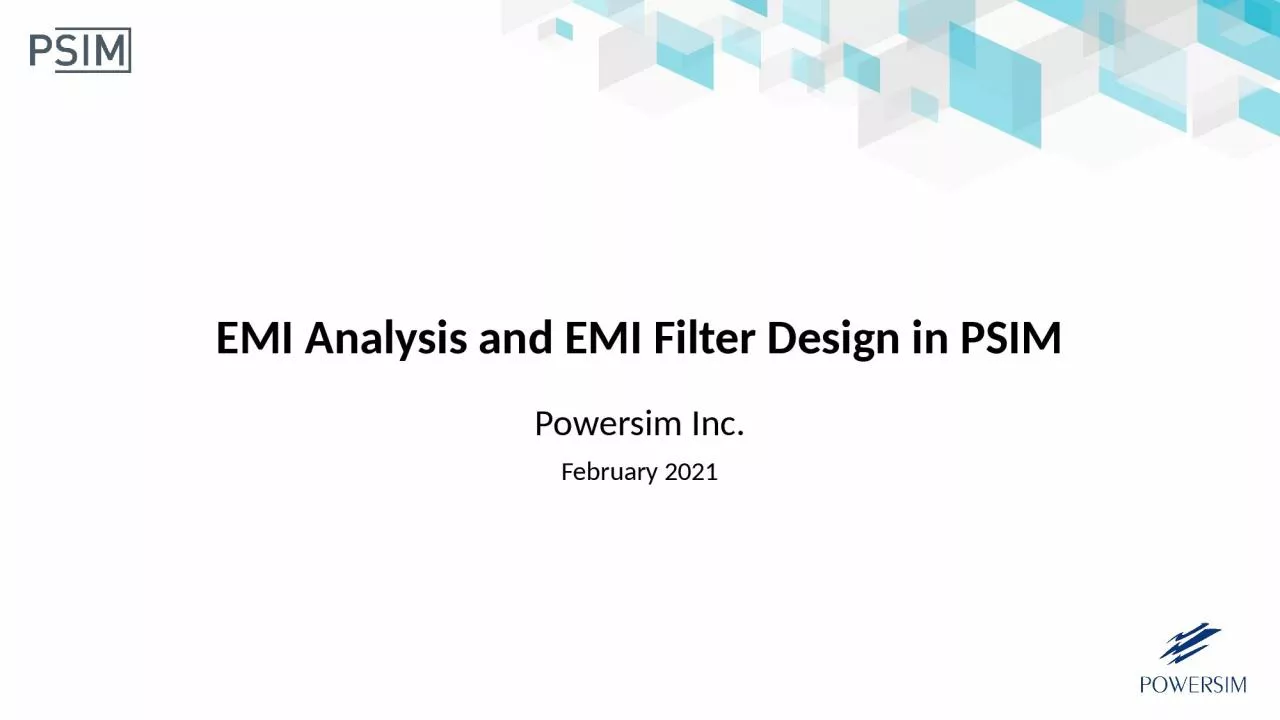

Powersim Inc February 2021 System engineering per customermarketing specifications Simulate and prototype to evaluate system power performance Provide detailed engineeringtesting specifications ID: 1017746
Download Presentation The PPT/PDF document "EMI Analysis and EMI Filter Design in PS..." is the property of its rightful owner. Permission is granted to download and print the materials on this web site for personal, non-commercial use only, and to display it on your personal computer provided you do not modify the materials and that you retain all copyright notices contained in the materials. By downloading content from our website, you accept the terms of this agreement.
1. EMI Analysis and EMI Filter Design in PSIMPowersim Inc.February 2021
2. System engineering per customer/marketing specificationsSimulate and prototype to evaluate system power performanceProvide detailed engineering/testing specificationsDesign engineering per engineering specificationsHW components selection, board and system layoutSW developmentTesting engineering per testing specificationsFunctional - Debug HW/SWThermalReliabilityEMIEMI pre-compliance testing per EMI standardsSet upDebugTypical Product Development Steps
3. There are no considerations and detailed engineering specifications related to EMI requirements (except EMI standards) from system engineering. When design engineers design the product, they tend to optimize the design for space, volume, power, cost and performance, but not EMI compliance. The EMI testing is always the very last step by testing engineersFunctional - Debug HW/SWThermalReliabilityEMIEMI pre-compliance set-up and debugging tasks are very confusing and time consumingProblem Statements
4. To help system engineers gain a better insight of the subsystem operations from EMI perspective and derive detailed hardware/mechanical layout specifications. To help hardware engineers carry out hardware component selection and EMI filter design to meet the EMI requirements before the actual circuit boards/system layout starts.To assist EMI debugging and find solutions after the hardware is built.To help EMI testing engineers quickly integrate and perform EMI pre-compliance testing of the system.The main goal: To address EMI issues upfront, not leave it as afterthought.Objectives of the EMI Design Suite
5. di/dt coupled with parasitic inductances and ESR of input capacitors => DMdv/dt coupled with parasitic capacitances => CMCauses of the EMI Noises
6. Causes of the EMI NoisesSwitching WaveformsFrequency Domain SpectrumOverlay EMI noise spectrum on top of CISPR 22 Standard
7. Set fsw value lower than ½ of EMI standard lower frequency limitMinimize parasitic inductances/capacitances with proper layout and component selectionReduce dv/dt => Increase power lossUse slower deviceIncrease gate resistanceAdd snubberOptimal number of filter stagesPossible EMI solutions without changing topology and modulation method:Mitigate EMI Noises
8. Accurately predict switching waveforms in time domain and the frequency domain spectrums of these switching waveformsMeasure EMI components (LISN, Signal Analyzer, CM/DM noise separator)Overlay EMI standards over EMI noise spectrumsAccurately predict the parasitic inductances and capacitances in the circuitAccurate EMI Analysis and EMI Filter Design in Simulation
9. EMI Design Suite TemplateDesign Input PanelThe following library blocks are provided:LISNEMI FilterSignal Analyzer (for CM and DM)Parasitic Capacitance BlockA general design template is provided. Users can add their own circuits to this template.
10. EMI Design Suite Examples5 design examples are provided.Buck (CISPR-22 Class-B)Boost (MIL-461 440V)PFC (FCC Class-B)PSFB DC-DC (CISPR-25 Level-4)PMSM Drive (CISPR-25 Level-3)
11. EMI Filter Design of PSFB Converter (CISPR25-Level 4)Without EMI filterWith EMI filter
12. Use Spice models provided by manufacturers.Bridge the gap between complex system simulation using the PSIM engine and detailed component investigation using the LTspice engine. Leverage built-in EMI components from the EMI Design Suite:Automatic EMI filter designLISNSignal Analyzer (with CM/DM noise separation)Parasitic Capacitance BlockLeverage rich set of post-processing functions in PSIM:FFTOverlay of various EMI standards Automatic unit conversions from Volts, Amps to dBuVRunning LTspice Simulation in EMI Design Suite Environment
13. EMI Filter Design of Buck Converter (CISPR22 Class-B) (using LTspice engine)
14. In the early design stage (pre-hardware build-up):To provide a qualitative and step-by-step guidance in EMI analysis and filter designTo study different “what if” scenarios, and study the effect of switching transient To provide guidance for board and system layout, or study the effect of the existing layout with consideration of various common-mode and parasitic componentsTo provide a common platform for system/HW/testing engineers to communicate and work through the EMI design/testing related issuesBenefits of the EMI Design Suite
15. In the late design stage (post-hardware build-up and design iterations):To assist EMI debugging and finding solutions after the hardware is builtTo load customer EMI measurement data, and use this data design the EMI filter using EMI Design SuiteTo help reduce the time for EMI filter design, debugging, and certification process significantly Benefits of the EMI Design Suite (cont’d)